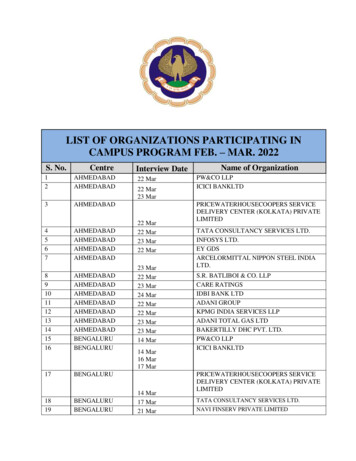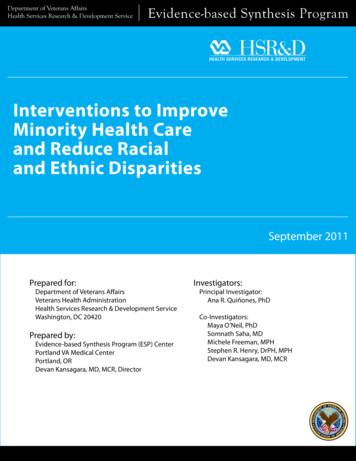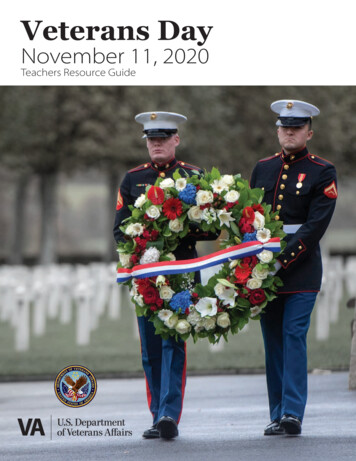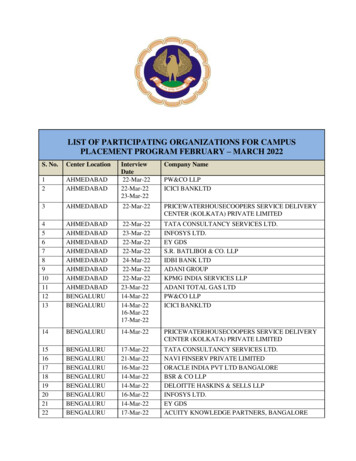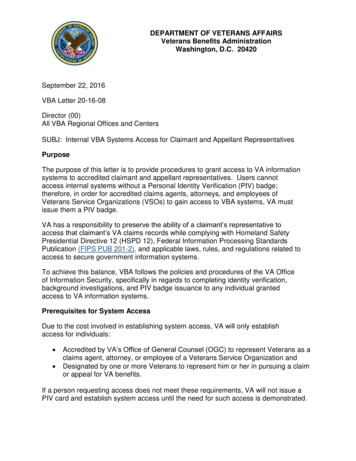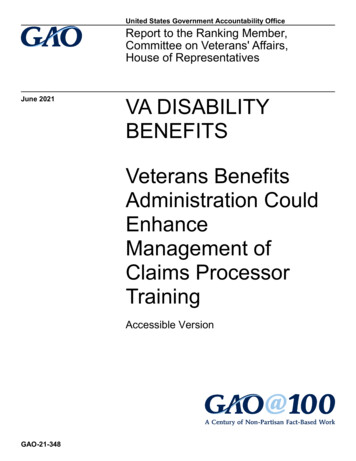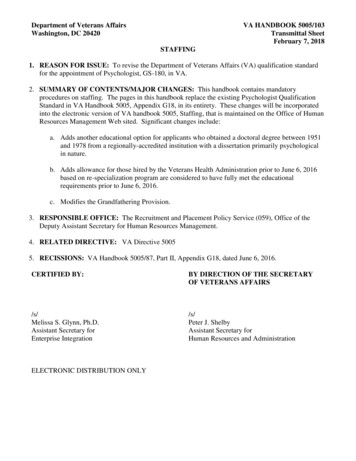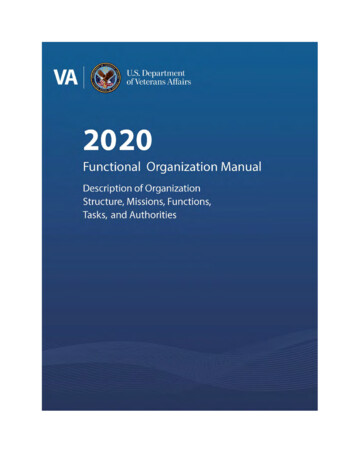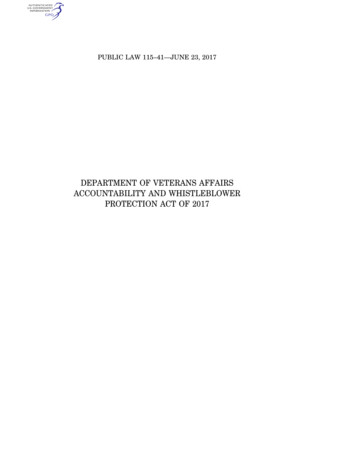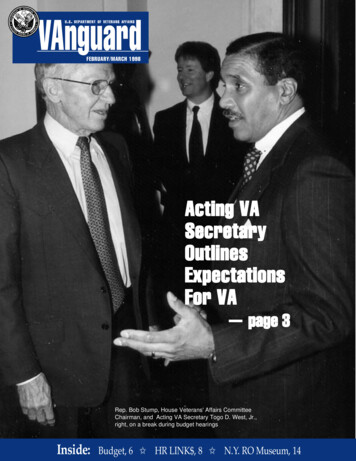
Transcription
U . S . DEPARTMENT OF VETERANS AFFAIRSVAnguardFEBRUARY/MARCH 1998Acting VASecretaryOutlinesExpectationsFor VA— page 3Rep. Bob Stump, House Veterans' Affairs CommitteeChairman, and Acting VA Secretary Togo D. West, Jr.,right, on a break during budget hearingsFebruary/March 1998Inside:Budget, 6 HR LINK , 8 N.Y. RO Museum, 141
C ONTENTS Computer System Tops 4Patient record system rolled outINTRODUCINGBuckley Peterson Primary Care Expands7Telecommunications involve Vet Centers Shared Service Center8HR LINK starts at 12 sites Franchise Funds11Pilot franchise funds make money Creative Arts Festival13Tomah VAMC hosts sold-out showCOLUMNS Medical Advances15 Have You Heard16 Honors19 Heroes20On The Cover:Photo by Michael MooreVAnguardVA’s Employee MagazineFebruary/March 1998Vol. XLIV, No. 2Printed on 50% recycled paperEditor: Laurie TranterGraphics: Michael NacincikPublished by theOffice of Public Affairs (80D)Department of Veterans Affairs810 Vermont Ave., N.W.Washington, D.C. 20420(202) 273-5738/5735E-mail: vanguard@mail.va.gov2When he decided to retire,Buckley Peterson could have just leftin 1997 and closed the book on hisVA career.Instead, the counseling psychologist from the Iowa VA RegionalOffice chose to “turn to a newchapter” and compile a volume onveterans who have benefited fromVA voc rehab and counseling. As aretired volunteer, he will continue towrite more accounts of veteranclients for the bookletto be used as a reference for the VAVocational Rehabilitation and CounselingService.“I liked the idea ofthese stories serving asa continuing testamentto the dreams, visionand determination ofthose veterans we areprivileged to serve,”Buckley said. “I wasoverwhelmed by thepositive response I gotfrom these veterans abouttheir lives following theirvoc rehab experiences.”With the idea endorsed by JackHackett, VR&C officer, Buckleyinterviewed veterans, took photographs and compiled his notes intoan informal book format. The 70veterans interviewed are representative of the veteran population intypes of disability and degree ofseverity of symptoms. They rangefrom self-employed veterans marketing a variety of goods and servicesfrom their homes to veterans pursuing careers and professions.“If you give the Voc Rehabprogram a chance to work, it willwork for you. It put me back up onsolid ground,” said Dyrone Welch,an Iowan who completed a one-yearwork experience training program atthe Des Moines VA Regional Office.An Army veteran, Welch said, “TheVA Voc Rehab program made medevelop a sense of responsibility andfeel needed.”Armed with transcription skillsand a command of computers, hebecame a customer service representative for CDS of Des Moines, a printshop.Several of the veterans Petersonwrites about have found ways toturn avocations into successfulvocations. Jodi Schleuger, forinstance, turned aninterest in horses intoher own businesstraining horses andtheir owners. VA VocRehab was Schleuger’spartner as she trainedin the Equine Management Program atEllsworth Community College in IowaFalls. Schleuger wasdeemed “a natural”by one instructor.Peterson workedfor the Iowa Department of VocationalRehabilitation as acounselor for 18 years before joiningthe Des Moines VA Regional Officein 1987 as a counseling psychologist.His work with disabled veterans wasrecognized in 1994 when he wasnamed VA Counseling Psychologistof the Year and Iowa’s Veterans’Small Business Advocate by theSmall Business Administration. Inaddition to such formal recognition,there have been personal expressions of appreciation from manyveteran clients and colleagues.VR&C has implemented, andeven pioneered, programs such asIndependent Living for those toodisabled to maintain competitiveemployment; Independent Instruction for those who aren’t well servedby the classroom; Employer Incentives to promote hiring veterans; andSelf-Employment, a program ofsmall business for veterans withdisabilities. VAnguard
OutlookTogo D. West, Jr.Acting SecretaryOf Veterans AffairsLet’s Keep America’s PromiseTo Veterans and Their Familiesconvenience. The VA health-caredecade ago. Through it all emergedsystem has broken out of the historian even greater, grander story — thecally bed-based mold of Americanstory of our nation’s veterans. Afterhealth care and is on its way tomy tour, I was left with a profoundappreciation for what VA employees becoming a model of patientfocused, managed care. The Nationalare doing today to keep our nation’sCemetery System is preparing topromise to its veterans throughmeet the challenge of unprecedentedcommitment to our historic mission:— to assure that veterans who, by demand for burial space and service.Your good ideas, hard work andtheir service and dedication haveexcellence have been recognized.earned a benefit from this nation,You have garnered many awards,receive it in a timely fashion;among them more than 100 National— to assure that veterans arePerformance Review Hammerprovided quality health care; and,Awards. Such recognition is impres— to assure that we providesive and important, but there areveterans who have served thismany measures of excellence. Thecountry the hero’s burial that agratefulnation,preservedThis is our true standard of excellence:in freedomthat every VA facility be a blessingby theirto the veterans and families it serves.efforts, isobligatedto provide.I know how far you have come in truest measure of excellence comesfrom those we serve. We know wethe last five years in meeting theseare most successful when we hearresponsibilities. You have led thefrom veterans and family membersway in government reinvention.who say, “My life is better for whatPaper-based procedures are beingyou do.”replaced by automated processesJust after I came to VA I read afocused on customer access andletter from a veteran’s daughter whowrote: “Two months ago my father,a Pearl Harbor veteran, became aAt budget briefings in February, Acting Secretary Togo D.resident of a VA rehabilitation andWest, Jr., outlined his expectations of VA in keeping theextended care center. Prior to that hispromise to America’s veterans:only desire was to die. He wascompletely nonfunctional. He could improve the timeliness and dependability of the deliverynot eat unless spoon fed and rarelyof benefits;spoke to anyone. Today my fatherdresses himself with little help and continue the transformation of VA’s health-care system,socializes with new-found friends.emphasizing quality, compassion and effectiveness;The VA has been a blessing and ananswer to our prayer.” assure employees a work environment that is conduciveThis is our true standard ofto their best efforts in behalf of veterans;excellence: that every VA facility bea blessing to the veterans and master the challenges of information technology, includingfamilies it serves. I look forward tothe looming issues of the year 2000; andworking with you in answeringthose prayers and keeping our more fully integrate the department’s organizationalnation’s promise to its heroes. elements.Preparationfor confirmationhearingsand myassumptionof responsibilities asActingSecretary ofVeteransAffairshave keptme close to home in Central Officeduring my first weeks at VA. I didmake a trip to New York in Januaryto dedicate the new Veterans BenefitsMuseum at the Regional Office,which put me in touch with the spiritas well as the substance of theDepartment’s mission.The museum chronicles thehistory of veterans’ benefits. As Iwalked through its exhibits, I saw avivid overview of the developmentof our veterans’ programs — theirgrowth during the Civil War, theirconsolidation in 1930 under theVeterans Administration, theirblossoming under the GI Bill afterWorld War II, and the elevation ofVA to a Cabinet department just aFebruary/March 19983
Computerized Patient Record System The BestVHA’s information technologyputs VA out in front with the national roll out of the ComputerizedPatient Record System (CPRS). Thesystem offers clinicians an improvedlook at patient data by presenting allelements on one screen at one timeUnlike an inch-thick paper file orcomputerized data files viewed onlyone at a time, CPRS makes allrelevant patient data — charts,records, notes and imagery — visibleon one screen in seconds for thepatient and doctor.tory system, but they don’t have theguarantee we have that those programs and all others will worktogether.”The Washington, D.C.,VAMC,was one of the first medical centersto implement CPRS, in addition toTuscaloosa, Ala., West Palm Beach,Fla., and Puget Sound (Seattle andAmerican Lake), Wash.San Francisco and Huntington,W. Va., VAMCs have followed as thefirst two key sites in their VISNs toimplement CPRS. The remaining keyAn example of what CPRS brings to the screen: a patient’s medical history (problems,medications, lab results), electrocardiogram results and an MRI of the patient’s cervical spine“VA will set the pace for theprivate sector with CPRS,” said Dr.Robert Kolodner, the Associate ChiefInformation Officer for BusinessEnterprise Solutions & Technology(BEST) Service.Many health-care providers atone of the first VA medical centersto implement CPRS heartily agree.“With the CPRS, VA is like theStarship Enterprise while privatesector hospitals are still hitting sticksagainst rocks,” said Dr. DanFernicola, cardiologist at the Washington, D.C., Medical Center. “Theymay have a better stand-alonepatient billing, pharmacy or labora-4sites scheduled to implement CPRSas part of Phase 2 of the nationalCPRS implementation project will doso by August 1998.VISN #7, headquartered inAtlanta, has already begun Phase 3of the national implementationproject, that is, rolling out CPRS tothe rest of its medical centers. Thenationwide implementation of CPRSat all VA medical centers, outpatientclinics, and nursing homes should becompleted in fiscal 1999.The VistA Imaging System makesit possible for clinicians to obtainpatient information graphicallydisplayed on the screen at theirclinical workstations.The Washington, D.C., VAMChas placed personal computers ineach of its primary care clinics sodoctors have ready access to patientdata to share it with the patients. “Aone-second click away are images ofa patient’s chest X-ray, CAT scan,MRI, endoscopy and electrocardiogram,” said Dr. Ross Fletcher, chiefof cardiology.“We’re excited about CPRSbecause it makes it easier for patientsto grasp information,” he said. “Ican sit with a patient and graphicallyillustrate to him how a certainmedication has been making adifference to his blood pressure orcholesterol count, for instance.”The speed with which patientdata can be called up impresses thechief medical resident at the Washington, D.C., VAMC, Dr. MaheshKrishnan. “If you’re in the emergency room, you can quickly pull upa patient’s electrocardiogram, forexample, and simultaneously reviewthe patient’s medical history.”Other sites that have implemented CPRS are reporting benefits,too. A Tuscaloosa VAMC clinician,Debra Lindley, said CPRS has been afactor in reducing waiting times inthe outpatient pharmacy from twohours to about 30 minutes. She saidalmost no uncompleted filingremains at the end of each day.“Karen Mariner, CIO at the West PalmBeach VAMC, reports that many ofthe medical center’s business processes have changed with CPRS andthat “the software has been a successand we consider CPRS a welcomeenhancement to our EMR [electronicmedical record].”The department has committed 2.7 billion to implementing itsoverall information technology overthe three years ending in federalfiscal 1998. In fiscal 1998, VA expectsto spend approximately 874 millionon its information systems.The office of VHA’s CIO has yet todecide whether private-sector doctors in community-based clinics under VA contract will be connected. VAnguard
VBA Selects 2 Deputy Under SecretariesThe Veterans Benefits Administration has named two deputyunder secretaries to serve onUnder Secretary for BenefitsJoe Thompson’s management team.Patrick Nappi is the DeputyUnder Secretary for Operations andNora Egan the Deputy Secretary forManagement.Nappi is responsible for theactivities of VBA’s field operations,Office of Human Resources and theOffice of Employee Developmentand Training. Egan is responsible forthe activities of VBA’s program andsupport offices.Both share, with the UnderSecretary, responsibility for managing benefits provided by VA, including education, home loan guaranty,compensation, pension, vocationalrehabilitation and life insurance.Nappi had served as the Directorof the Central Area since May 1996.In this capacity he was responsiblefor the operation of all VA benefitsfacilities in the central part of theUnited States — 13 field stations andthe Records Management Center,serving some 7 million veterans inthe 13 midwestern states. Previ-ously, Nappi served as the Directorof the San Diego VA Regional Office.He began hisVA career at theBuffalo RO as aveterans benefitscounselor in 1974and four yearslater became amanagementanalyst. He joinedthe VBA FieldNappiOperations staffin Washington, D.C., in 1983, servingin a number of management positions before being named ExecutiveAssistant to the Deputy ChiefBenefits Director in 1990.Nappi has a bachelor of sciencedegree from Syracuse University in1968. He served in Vietnam with the3rd Battalion, 5th Marine Regiment,and retired from the Army NationalGuard as a Brigadier General in 1995.Egan is the former DeputyAssistant Secretary for Planning inVA’s Office of Policy and Planning, aposition she assumed in May 1995.She was responsible for developingand maintaining a national strategicplanning program and directingVA’s quality improvement program.Egan was honored in 1995 with thePresidential Rank Award.Egan previously served as theAssociate Deputy Assistant Secretaryfor Human Resources Management.In that capacity, she developed,coordinated and implementedpersonnel polices governing pay,labor relations and employee relations. Her involvement in VA’shealth-care reform initiatives led to amajor role in the development ofVA’s Under Secretary for Health’sVision for Change.A career VAemployee, Eganhas more than 22years of federalservice, all withVA. Previousassignmentsinclude PersonnelOfficer for VACentral Office andEganDirector of Employee Relations and PerformanceManagement Service.Egan holds a bachelor’s degree inpolitical science from ManhattanvilleCollege in Purchase, N.Y. Waco Regional Office Dedicates New BuildingThe Waco Regional Office dedicated its new 127,000 squarefoot building, located downtown, on Dec. 8.The move downtown givesemployees more office space, freeparking and a cafeteria. The locationis more accessible for veterans,especially those using public transportation.“A city that develops its downtown, its heart, is destined for ahealthy future,” said U.S. Rep. ChetEdwards (D-Waco). He recentlymoved his Waco district office to thenew building.Downtown retailers also arehappy about the move that shouldgenerate new business for them.Employees had plenty to sayabout their new building that is40,000 square feet larger than the oldregional office.“I’m pleased with the additionalFebruary/March 1998space,updatedfurnishings,cleanlinessand improvedaestheticenvironment,” saidone satisfiedemployee.“I likehavingsecuritybadges thatunlock thedoors to thedivisions,restroomsand entrance From left, Deputy Secretary Hershel Gober, Congressman Chet Edwards,Waco Mayor Michael D. Morrison and VA Under Secretary for Benefitsdoors,” saidJoe Thompsonanotheremployee about thebuilding’s security system. 5
VA’s 1999 Budget Submitted to CongressFor fiscal 1999, VA is requesting 42.8 billion for mandatory anddiscretionary programs.“We are committed to providing quality care and services to ournation’s veterans, who have servedand sacrificed in defense of ourfreedom. This budget keeps thatpromise,” said Acting Secretary ofVeterans Affairs Togo D. West, Jr.The budget provides for: 17.7 billion for medical care; 21.9 billion for compensation andpension payments; 92 million for the NationalCemetery System, an 8 percentincrease over 1998; a 10 percent increase in fundingfor medical research; and a 7 percent increase to administerveterans benefits.During the next five years, VAwill work to: reduce per patient costfor health care by 30 percent; increase the portion of the operatingbudget obtained from non-appropriated sources by 10 percent; andultimately serve 20 percent moreveterans.The President’s proposal includesa demonstration program in 1998 totest the feasibility of VA billingMedicare-eligible, higher-incomeveterans without compensabledisabilities. This program, along withthe ability to retain collections fromthird parties, copayments and othersources under the provisions of theBalanced Budget Act of 1997, willincrease by nearly 700 million theamount of funding VA receives fromnon-appropriated sources.The budget increases mandatoryMontgomery GI Bill educationbenefits by 20 percent, or 191million, in 1999 — the most significant increase in benefits since theprogram’s inception in 1984.The VA 1999 budget containsthese additional highlights:Benefits ProgramIncluded is appropriation language designed to eliminate end-ofyear funding shortages by providingnecessary funding for payment ofbenefits.Also, the Administration hasproposed the following benefitsrelated legislation in 1999: To disallow compensation benefits6for tobacco-related disabilities. Thisproposal would restrict serviceconnected disability compensationbenefits for tobacco-related conditions which become manifest afterservice discharge and beyond anyapplicable presumptive period,based solely on tobacco use duringmilitary service. The savings in 1999are estimated to be 741 million, witha projection of approximately 17billion in savings over five years. 25 million over five years to payfull veterans disability and compen-The budget includes 300 millionfor medical research.This program ispart of the Administration’s expansion of research efforts through the“Research Fund for America.”For medical and prostheticresearch, a total of 300 million and3,159 employees for than 1,795 highpriority research projects that willenhance the quality of VA healthcare.The budget also includes alegislative proposal that wouldauthorize a new smoking cessationVA EmploymentBuyouts 9,622 RIFs 1,673 Attrition 104,421250,000234,428 233,062 228,487221,855211,507 1995Medical Care1996VBA1997All Other19981999** proposed in President’sbudget requestBuyouts, RIFs and attrition totals are for 1994 - 1998.sation benefits to Filipino veteransand their survivors residing in theUnited States who are currentlyreceiving these benefits at half thelevel that U.S. veterans receive. To provide 100 million for veterans training programs administeredby the Department of Labor. To eliminate vendee home loansmade to the general public, for anestimated savings in 1999 of 2million, with five-year savings of 43million. VA will sell all foreclosedproperties on a cash basis. To charge a 25 fee for each VAhome loan that is guaranteed andexpect to collect up to 15 million.Medical ProgramsVHA expects to open 71 newoutpatient clinics and treat 134,000more veterans in 1999 than in 1998, afour percent increase.program for honorably dischargedveterans who began smoking in themilitary. Veterans will be eligible tothe extent that resources are available. Once this program is authorized, the Administration will submita budget amendment requesting anappropriation of 87 million.Construction ProgramsVA’s 285 million constructionrequest includes funding to correctseismic vulnerabilities at facilitiesand for the construction ofcolumbaria niches at nationalcemeteries.National Cemetery SystemNCS’ higher funding and FTElevels will permit opening four newcemeteries during the next two years— a number unprecedented since theend of the Civil War. VAnguard
Primary Care Expansion Involves Vet CentersUsing advances in telecommunications technology, VAhas expanded primary healthcare programs nationwidethrough its network of “Vet Centers,” which routinely providecounseling services to combat ortraumatized veterans.In addition to 3 million inequipment and startup operatingcosts related to telemedicine at 20locations, an additional 1 million isbeing provided to expand andenhance conventional primary careprograms at 10 Vet Centers.“Our goal is to promote access toprimary care for veterans closer totheir communities,” VA UnderSecretary for Health Dr. Kenneth W.Kizer said. “This latest effortcomplements the initiative launchedin late 1994 to implement universalprimary care at VA medical centersacross the nation, as well as the over100 community-based clinics wehave established in the last twoyears,” Dr. Kizer said.The Vet Center-linked initiativeswill promote services such as healthscreenings for chronic diseases,health prevention programs, sexualtrauma outreach and counseling, andpsychosocial services. The programswill target special populations,including high-risk groups, minorityveterans and veterans who facebarriers to care, such as disabled andhomeless veterans.For example, the Navajo VetCenter outstation in Chinle, Ariz.,will provide health screenings forhypertension and diabetes as wellas psychiatric assessments andconsultations with Native Americanson reservation lands, while the Philadelphia, Pa., Vet Center will provide health screenings and follow-upmedical care to a minority veteranpopulation of primarily Puerto Ricanand African-American background.The 20 sites participating intelemedicine initiatives will linkrural and urban Vet Centers, VAmedical centers, and other community agencies and resources.Telemedicine uses electronic information and communication technologies to support health care overlong distances through such applications as teleconferences or retrievalof networked records.This initiative is part of VA’songoing major effort to make itsservices more community-based.The program is separate from VA’sdevelopment of community-basedoutpatient clinics, another initiativedesigned to increase access points forVA health care. Program Expansion SitesNorwich, Conn.Sanford, MaineCleveland, OhioCharleston, W.Va.Philadelphia, Pa.Cedar Rapids, IowaSioux City, IowaPine Ridge-Rosebud, S.D.Greenville, N.C.Greenville, S.C.San Juan, P.R.Tahlequah, Okla.Midland, TexasLaredo, TexasFt. Collins, Colo.Chinle, Ariz.Keams Canyon, Ariz.Eureka, Calif.Chico, Calif.Vista, Calif.Alexandria, Va.Shreveport, La.New Orleans, La.Houston, TexasAnaheim, Calif.Salem, Ore.VA, DoD Combine Health-Care EffortsUnder an agreement betweenVA and the Department ofDefense (DoD), active dutymilitary personnel should getfaster decisions on their disabilitycompensation claims and requestsfor VA health care. Separating orretiring servicemembers who expectto file a claim for VA disabilitycompensation will undergo a singlephysical examination prior todischarge.The departments also agreed oninitiatives to conduct joint research,reduce overlapping services andhave their health-care systems worktogether.The discharge exam will meetVA’s requirements for claim determinations and DoD’s need for separa-February/March 1998tion exams. The results of theseexams help determine eligibility forVA health care.In pilot tests of the dual-purposeexam at VA and Army facilities,claims processing time was reducedto less than one-third of nationallevels under the current system. Thecurrent average time for processingan original compensation claim is133 days.Under the new plan, VA physicians generally will conduct the predischarge exams. Where VA physicians are unavailable, DoD physicians will conduct them according toVA protocols.A council of senior VA and DoDhealth officials agreed to worktoward reimbursable arrangementsbetween the two departments. Otherinitiatives include: establishing a Military and Veterans Health Coordinating Board,building on the experience of theJoint Gulf War Illnesses Group. allowing patients in both systemsto use specialized treatment centersin each department. creating compatible computerizedmedical records and sharing automation products. Creating joint clinicalpractice guidelines and coordinatingon laboratory and pathology programs.The collaboration was spearheaded by VA Under Secretary forHealth Dr. Kenneth Kizer and ActingAssistant Secretary of Defense forHealth Affairs Dr. Edward D.Martin. 7
Personal Record Changing Gets Easier —Moved? Married or divorced? Changing insurance beneficiaries orcoverage? Some 12,000employees at 12 VA locations arebeginning to perform their ownpersonal actions simply by touchinga computer screen or picking up aphone and using a personal identifi-system — to change personal information or pay records that rangefrom Thrift Savings Plan allotmentsto tax withholding deductions, morethan 20 transactions in all.Later this year, in Phase 3, managers in the same facilities will beinitiating recruitment and classification on their desktop computers withVA’s NewNew HR/PayrollVA’sHR/PayrollEmployee Self-Service ModelEmployee Self-Service ModelKiosk/PCVA WorkforceAmy 123-45-6789PIN #12341-800 NumberFront End IVRInfo/TransTechnology Platform PeopleSoft TALX (IVR) LOTUS Notes/HTMLSSC OUTPUTTier 1Generalistcation number.By the end of 2000, all VAemployees will be using HR LINK to electronically access and changetheir records.HR LINK — the automation ofVA’s personnel and payroll functions — entered its second phaseMarch 2 with the opening of theShared Service Center in Topeka,Kans. The SSC is the operational“link” in the new system, supportedby computer operations at theAustin Automation Center andtechnological development at the HRLINK project office in VACO.Recently tested by selectedemployees, including union representatives, at the 12 prototype sites,HR LINK Phase 2 self-servicing isnow available to all employees atthose sites. Seven days a week, 24hours a day, they can use a kiosk ora touch-tone phone — through aninteractive voice response (IVR)8SharedService CenterTopeka, KSTier 2SpecialistTier 3Expert“expert” systems. The mostly manualstaffing and classification processesof the past can take months to createand fill a job.With the new expert systems,managers will select from a library ofposition descriptions to classify jobs,with grades attached and grade-automated applications, which willbe rated and ranked automatically atthe SSC to create referral lists.Employees at the prototype siteswill be able to make their personaltransactions from desktop computersin Phase 3, as well.Phase 1 of HR LINK began lastyear as PAY VA. HR staff at theprototype sites tested and then beganusing the new technology to tracksuch things as licensure, skills,accommodations and priorityplacements. Not until Phase 4 HRwill HR LINK take on timekeepingand payroll recordkeeping. Eachphase will be tested at the prototypesites before going nationwide.This faster, easier, more privateand less costly way to processemployee transactions and personnelactions was developed in the officesof the Assistant Secretaries forHuman Resources and Administration and for Management. HR LINK technologies automate proceduresthat previously required submittingpaperwork or visiting HR or payrolloffices.Says SSC Director BruceCarruthers, “I am reluctant to use theword ‘empower’ because it hasbecome a stock term, but that’s whatthis system does for employees andeventually will do for managers. Itwill enable them to perform theirown transactions and to deal withwork force issues in a timely, costeffective way.”At the end of January he directeda staff of 78, a number that couldgrow to 350 when HR LINK is fullyoperating VA-wide. The SSC isHR LINK reduces paper, redundancy andmisplaced documents. It offers access anywhereand keeps employee information secure.controlling duties highlighted.Managers will process and routetheir transactions electronically.Employees will be able to submitorganized in tiers, the first tier beingthe CSRs, who help employees carryout their transactions. The CSRsanswer questions by referring toVAnguard
HR LINK Now at 12 Locationscomputerized books of scriptedinformation on a range of topics thatinclude “life events.” Someone whocalls to report getting married, forexample, will not only be able tomake the status change but will beoffered a life event package ofinformation for considering changesin benefits. The packages can also beordered directly through a kiosk orphone. If employees at phones orkiosks decide to seek help to complete on-line transactions or havequestions, the CSRs will be availableon business days from 7:30 a.m. to5:30 p.m. EST. They have the detailson a wide range of topics to read tothem — in more than 1,100 scripts.(All SSC support to prototype siteswill be available during thosebusiness hours.)When the scripts have notanswered a caller’s question, theCSRs open a “case” detailing theemployee’s concerns. They thenforward it for handling, at the SSC‘ssecond tier of expertise, to a specialist who researches the matter andcalls the person back. The datagathering screen for opening a caseeven permits the CSR toassign a priority for the specialist.The volume of business —especially from employees seekingthe help of CSRs in the currentprototype — will determine eventualstaffing. A major part of the SSC staffwill be the Tier 1 CSRs, who provideinitial service to employees byphone. Their positions are at the GS5 level.Other SSC staff include the Tiers2 and 3 personnelspecialists, employment systemstechnicians, management and systemsanalysts, programdevelopmentspecialists, information systems staffand HR and fiscalstaff internal to theSSC. These positionsrange from GS-6 to13.Currently, theSSC is recruitingpeople with personnel managementbackgrounds. VAemployees receivepreference for SSCjobs and relocationexpenses.When the PAYVA (now HR LINK )project began,project officialsestimated that itsefficiencies wouldel
gency room, you can quickly pull up a patient's electrocardiogram, for example, and simultaneously review the patient's medical history." Other sites that have imple-mented CPRS are reporting benefits, too. A Tuscaloosa VAMC clinician, Debra Lindley, said CPRS has been a factor in reducing waiting times in the outpatient pharmacy from two
